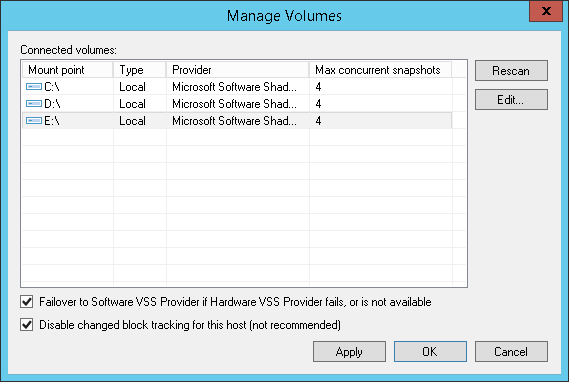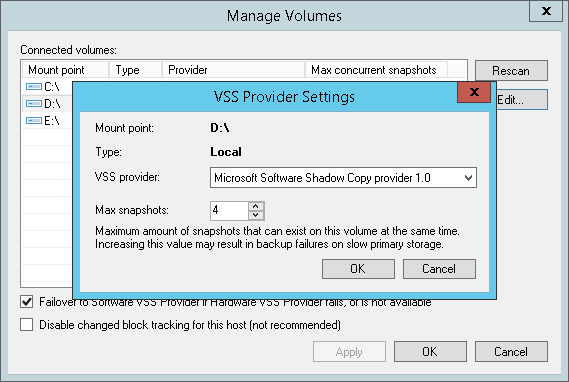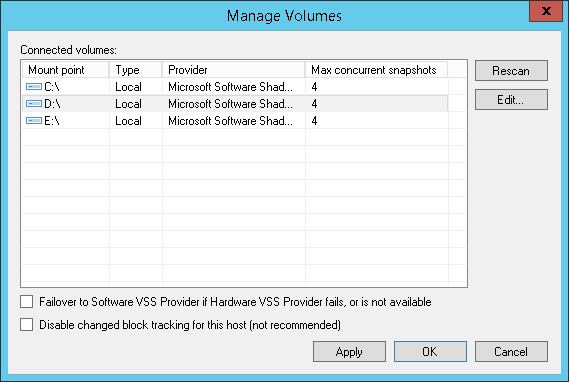 This is an archive version of the document. To get the most up-to-date information, see the current version.
This is an archive version of the document. To get the most up-to-date information, see the current version.Step 7. Specify Settings for Connected Volumes
After you add a Microsoft Hyper-V host to the backup infrastructure, you can configure the following settings for the host:
- Enable or disable changed block tracking
- Specify volume-specific settings
- Enable or disable failover to a software VSS provider
Before you specify settings for a Microsoft Hyper-V host, you must rescan volumes of the added host. During volume rescan, Veeam Backup & Replication retrieves information about disks and volumes that are currently connected to the Microsoft Hyper-V host and writes this information to the configuration database.
Veeam Backup & Replication automatically performs volume rescan once a day. You can also start volume rescan manually:
- Open the Backup Infrastructure view.
- In the inventory pane, select Managed servers.
- In the working area, select the host and click Rescan on the ribbon. Alternatively, you can right-click the host and select Rescan.
Changed Block Tracking Settings
By default, Veeam Backup & Replication uses changed block tracking for processing all VMs that reside on Microsoft Hyper-V hosts. You can disable changed block tracking, for example, for testing purposes.
Change block tracking is enabled and disabled at the level of the Microsoft Hyper-V host. To disable changed block tracking:
- Open the Backup Infrastructure view.
- In the inventory pane, select Managed servers.
- In the working area, select the host and click Manage Volumes on the ribbon. Alternatively, you can right-click the host and select Manage Volumes.
- In the Manage Volumes window, select the Disable changed block tracking for this host check box.

You can define volume-specific settings for a Microsoft Hyper-V host: select what VSS provider must be used for snapshot creation and specify the maximum number of concurrent snapshots that must exist for the volume.
To specify volume-specific settings:
- Open the Backup Infrastructure view.
- In the inventory pane, select Managed servers.
- In the working area, select the host and click Manage Volumes on the ribbon. Alternatively, you can right-click the host and select Manage Volumes.
- Select the volume in the list and click Edit.
- To take a VSS snapshot of a specific volume, Veeam Backup & Replication uses one of VSS providers available for this volume. To explicitly define what VSS provider must be used for the volume, select the VSS provider from the VSS provider list. If a VSS provider is not set explicitly, Veeam Backup & Replication will scan the list of available VSS providers and select the most appropriate one automatically.
- By default, jobs working with the same volume can take up to 4 snapshots of the volume simultaneously. If necessary, you can increase or decrease the number of snapshots that can exist at the same time. It is not recommended that you increase the number of snapshots for slow storage. A great number of snapshots existing at the same time may cause VM processing failures.

VSS Provider Failover Settings
If you have selected to use a hardware VSS provider, Veeam Backup & Replication uses the specified hardware VSS provider for volume snapshot creation. If the hardware VSS provider does not manage to create a volume snapshot for some reason, Veeam Backup & Replication automatically fails over to a software VSS provider.
By default, the failover option is enabled. To disable failover to a software VSS provider:
- Open the Backup Infrastructure view.
- In the inventory pane, select Managed servers.
- In the working area, select the host and click Manage Volumes on the ribbon. Alternatively, you can right-click the host and select Manage Volumes.
- In the Manage Volumes window, clear the Failover to Software VSS Provider if Hardware VSS Provider fails, or is not available check box.
